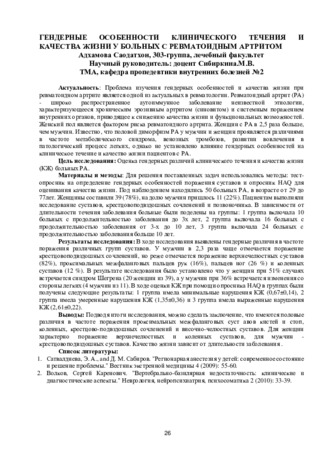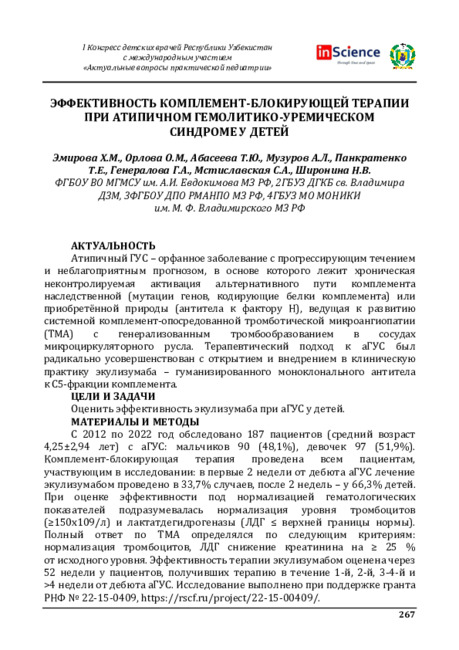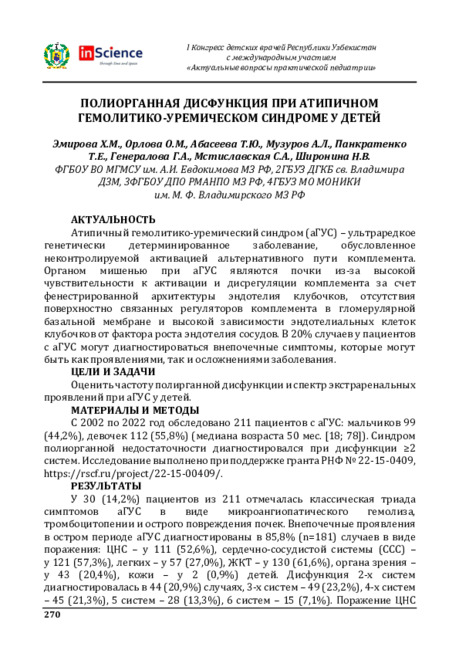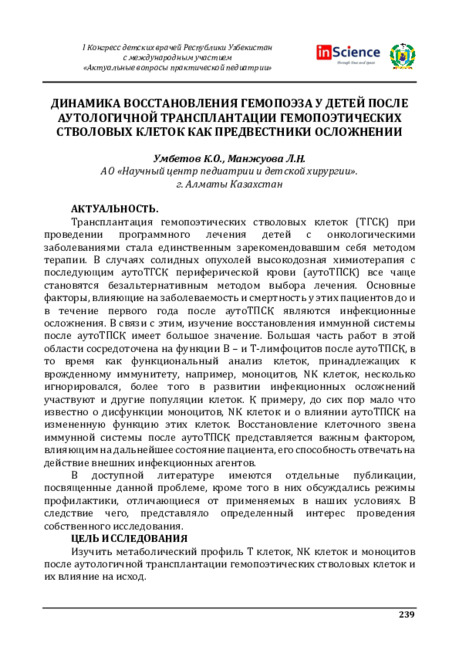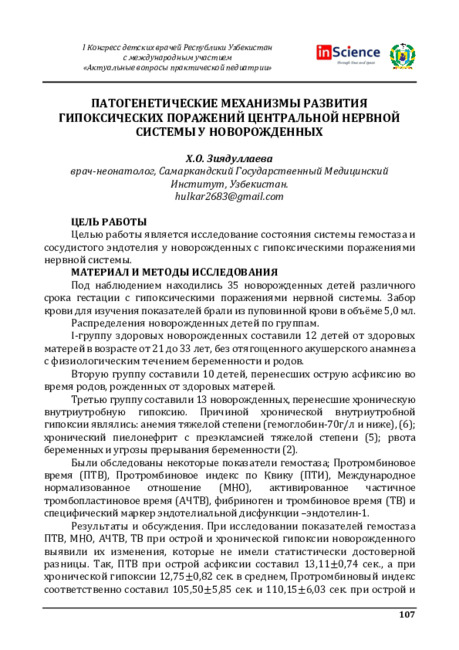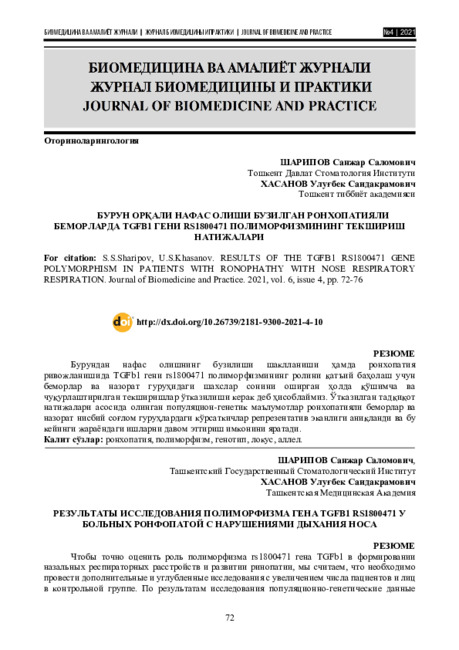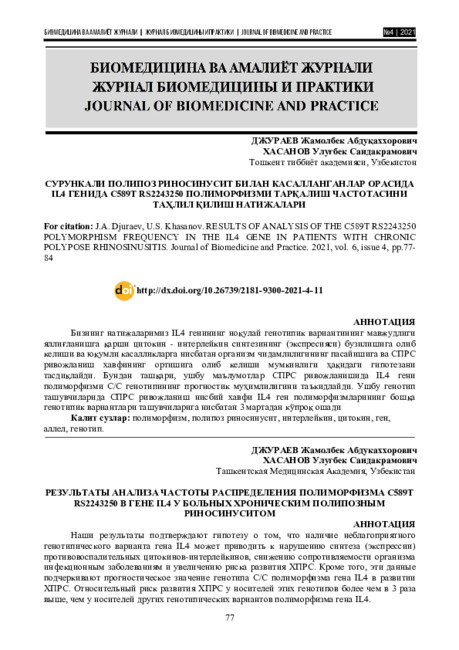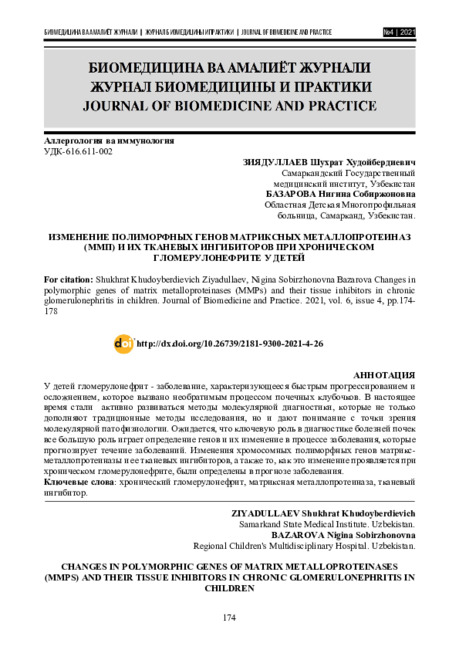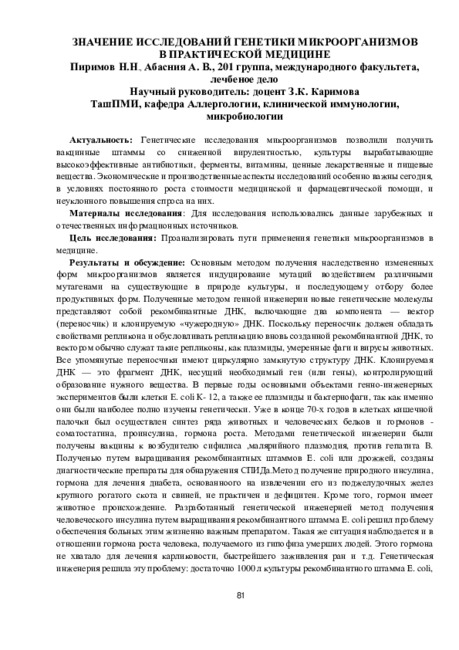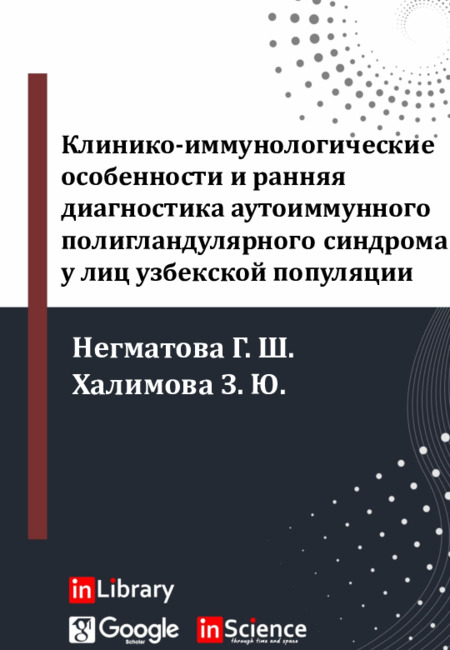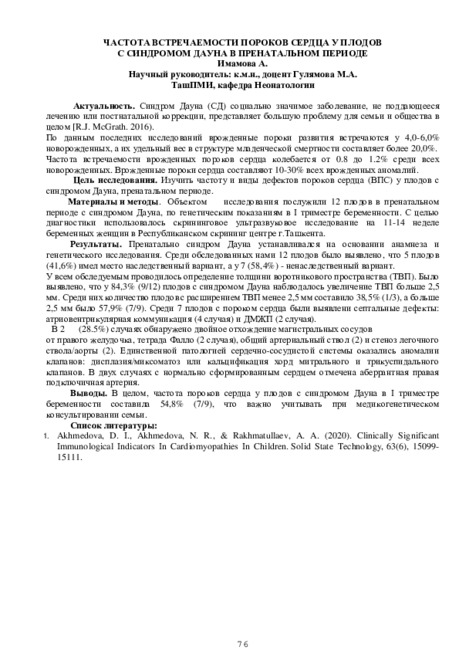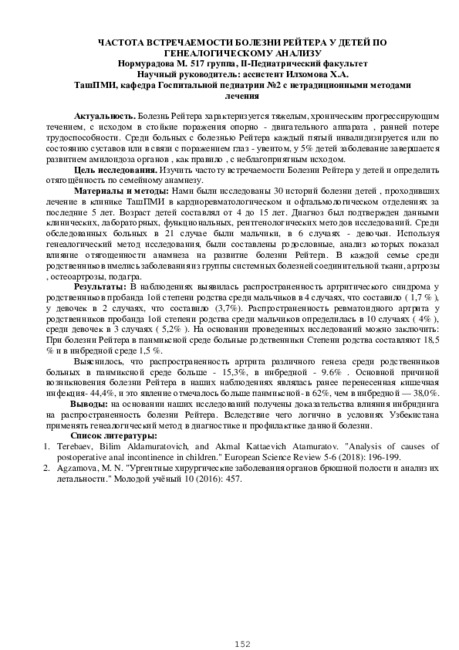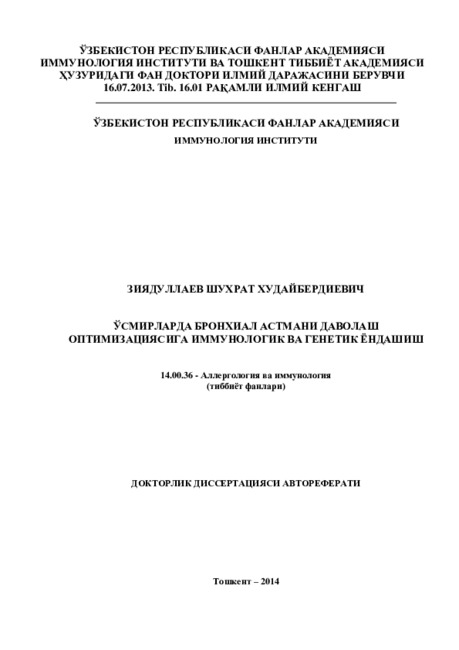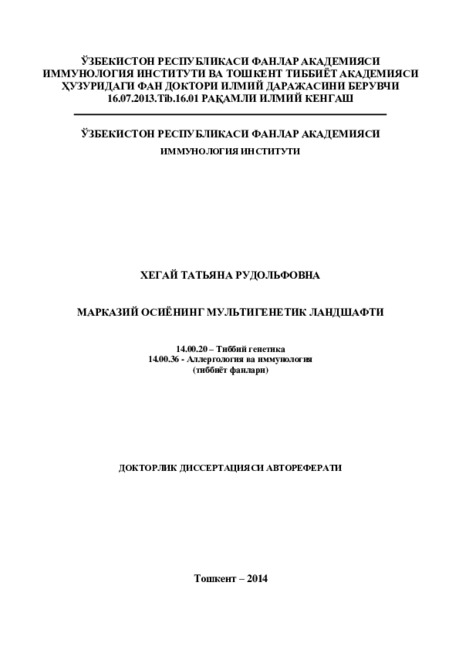All articles - Genetics and Heredity
-
Гендерные особенности клинического течения и качества жизни у больных с ревматоидным артритом
Prospects for the development of medicineПроблема изучения гендерных особенностей и качества жизни при ревматоидном артрите является одной из актуальных в ревматологии. Ревматоидный артрит (РА) – широко распространенное аутоиммунное заболевание неизвестной этиологии, характеризующееся хроническим эрозивным артритом (синовитом) и системным поражением внутренних органов, приводящее к снижению качества жизни и функциональных возможностей. Женский пол является фактором риска ревматоидного артрита. Женщин с РА в 2,5 раза больше, чем мужчин. Известно, что половой диморфизм РА у мужчин и женщин проявляется различиями в частоте метаболического синдрома, венозных тромбозов, развитии вовлечения в патологический процесс легких, однако не установлено влияние гендерных особенностей на клиническое течение и качество жизни пациентов с РА.
-
Эффективность комплемент-блокирующей терапии при атипичном гемолитико-уремическом синдроме у детей
Актуальные вопросы практической педиатрииАтипичный ГУС – орфанное заболевание с прогрессирующим течением и неблагоприятным прогнозом, в основе которого лежит хроническая неконтролируемая активация альтернативного пути комплемента
наследственной (мутации генов, кодирующие белки комплемента) или приобретённой природы (антитела к фактору Н), ведущая к развитию системной комплемент-опосредованной тромботической микроангиопатии
(ТМА) с генерализованным тромбообразованием в сосудах микроциркуляторного русла. Терапевтический подход к аГУС был радикально усовершенствован с открытием и внедрением в клиническую практику экулизумаба – гуманизированного моноклонального антитела к С5-фракции комплемента. -
Полиорганная дисфункция при атипичном гемолитико-уремическом синдроме у детей
Актуальные вопросы практической педиатрииАтипичный гемолитико-уремический синдром (аГУС) – ультраредкое генетически детерминированное заболевание, обусловленное неконтролируемой активацией альтернативного пути комплемента. Органом мишенью при аГУС являются почки из-за высокой чувствительности к активации и дисрегуляции комплемента за счет фенестрированной архитектуры эндотелия клубочков, отсутствия поверхностно связанных регуляторов комплемента в гломерулярной базальной мембране и высокой зависимости эндотелиальных клеток клубочков от фактора роста эндотелия сосудов. В 20% случаев у пациентов с аГУС могут диагностироваться внепочечные симптомы, которые могут быть как проявлениями, так и осложнениями заболевания.
-
Динамика восстановления гемопоэза у детей после аутологичной трансплантации гемопоэтических стволовых клеток как предвестники осложнении
Актуальные вопросы практической педиатрииТрансплантация гемопоэтических стволовых клеток (ТГСК) при проведении программного лечения детей с онкологическими заболеваниями стала единственным зарекомендовавшим себя методом терапии. В случаях солидных опухолей высокодозная химиотерапия с последующим аутоТГСК периферической крови (аутоТПСК) все чаще становятся безальтернативным методом выбора лечения. Основные факторы, влияющие на заболеваемость и смертность у этих пациентов до и в течение первого года после аутоТПСК являются инфекционные осложнения. В связи с этим, изучение восстановления иммунной системы после аутоТПСК имеет большое значение. Большая часть работ в этой области сосредоточена на функции В - и Т-лимфоцитов после аутоТПСК, в то время как функциональный анализ клеток, принадлежащих к врожденному иммунитету, например, моноцитов, NK клеток, несколько игнорировался, более того в развитии инфекционных осложнений участвуют и другие популяции клеток. К примеру, до сих пор мало что известно о дисфункции моноцитов, NK клеток и о влиянии аутоТПСК на измененную функцию этих клеток. Восстановление клеточного звена иммунной системы после аутоТПСК представляется важным фактором, влияющим на дальнейшее состояние пациента, его способность отвечать на действие внешних инфекционных агентов.
-
Патогенетические механизмы развития гипоксических поражений центральной нервной системы у новорожденных
Актуальные вопросы практической педиатрииЦелью работы является исследование состояния системы гемостаза и сосудистого эндотелия у новорожденных с гипоксическими поражениями нервной системы.
-
Частота распределения полиморфных вариантов гена MTRR у новорожденных с задержкой внутриутробного развития
Актуальные вопросы практической педиатрииНаучные работы последних лет значительно расширяют наши представления о роли генетических факторов в возникновении и развитии различных патологических состояний и заболеваний у плода. Выявленные в последние годы корреляционные взаимосвязи полиморфизма генов с предрасположенностью или устойчивостью к различной патологии определяют патогенетическую основу молекулярной генетики заболеваний у плода и новорожденного. На сегодняшний день показана возможность возникновения гипергомоцистеинемии и связанных с ней патологических состояний в результате нарушения функции ферментов, участвующих в фолатном обмене - MTHFR, MTRR, MTR.
-
Results of the TGFB1 RS1800471 gene polymorphism in patients with ronophathy with nose respiratory respiration
Journal of Biomedicine and PracticeTo accurately assess the role of the rs1800471 polymorphism of the TGFb1 gene in the formation of nasal respiratory disorders and the development of rhinopathy, we believe that it is necessary to conduct additional and in depth studies with an increase in the number of patients and individuals in the control group. According to the results of the study, population genetic data turned out to be representative in relatively healthy groups of patients with rhinopathy and control, which allows us to continue working in the following process.
-
Results of analysis of the C589T RS2243250 polymorphism frequency in the il4 gene in patients with chronic
Journal of Biomedicine and PracticeOur results confirm the hypothesis that the presence of an unfavorable genotypic variant of the IL4 gene can lead to a violation of the synthesis (expression) of anti-inflammatory cytokines-interleukins, a decrease in the body's resistance to infectious diseases, and an increase in the risk of developing CPRS. In addition, these data emphasize the prognostic significance of the C/C genotype of the IL4 gene polymorphism in the development of CPRS. The relative risk of developing CPRS in carriers of these genotypes is more than 3 times higher than in carriers of other genotypic variants of IL4 gene polymorphism.
-
Changes in polymorphic genes of matrix metalloproteinases (MMPS) and their tissue inhibitors in chronic glomerulonephritis in children
Journal of Biomedicine and PracticeIn children, glomerulonephritis is a disease characterized by rapid progression and complication caused by an irreversible process of the renal glomeruli. Currently, methods of molecular diagnostics have begun to actively develop, which not only complement traditional research methods, but also provide insight from the point of view of molecular pathophysiology. It is expected that a key role in the diagnosis of kidney disease is played by the identification of genes and their changes in the course of the disease, which predict the course of the disease. Changes in chromosomal polymorphic genes of matrix metalloproteinase and its tissue inhibitors, as well as how this change manifests itself in chronic glomerulonephritis, were determined in the prognosis of the disease.
-
Значение исследований генетики микроорганизмов в практической медицине
Современная медицина глазами молодых ученыхГенетические исследования микроорганизмов позволили получить вакцинные штаммы со сниженной вирулентностью, культуры вырабатывающие высокоэффективные антибиотики, ферменты, витамины, ценные лекарственные и пищевые вещества. Экономические и производственные аспекты исследований особенно важны сегодня, в условиях постоянного роста стоимости медицинской и фармацевтической помощи, и неуклонного повышения спроса на них.
-
Clinical and immunological features and early diagnosis of autoimmune polyglandular syndrome in the Uzbek population
Catalog of monographsМонография посвящена аутоиммунным полиглаидулярным синдромам (АПС), которые в настоящее время являются одной из актуальных проблем эндокринологии. АПС - редкая полиэндокринопатия, которая характеризуется поражением нескольких эндокринных желез и неэндокринных тканей в результате иммунных нарушений. Обычно это приводит к снижению активности участников. Скрининг, диагностика, иммуногенетическое, эпидемиологическое и клиническое изучение АПС является одним из актуальных направлений современной эндокринологии.
Монография расчитана для врачей- эндокринологов, клинических ординаторов, резидентов и студентов медицинских вузов -
Частота встречаемости пороков сердца у плодов с синдромом Дауна в пренатальном периоде
Scientific works of gifted youth and medicine of the XXI centuryСиндром Дауна (СД) социально значимое заболевание, не поддающееся лечению или постнатальной коррекции, представляет большую проблему для семьи и общества в целом [R.J. McGrath. 2016).
По данным последних исследований врожденные пороки развития встречаются у 4,0-6,0% новорожденных, а их удельный вес в структуре младенческой смертности составляет более 20,0%. Частота встречаемости врожденных пороков сердца колебается от 0.8 до 1.2% среди всех новорожденных. Врожденные пороки сердца составляют 10-30% всех врожденных аномалий. -
Частота встречаемости болезни Рейтера у детей по генеалогическому анализу
Scientific works of gifted youth and medicine of the XXI centuryБолезнь Рейтера характеризуется тяжелым, хроническим прогрессирующим течением, с исходом в стойкие поражения опорно - двигательного аппарата , ранней потере трудоспособности. Среди больных с болезнью Рейтера каждый пятый инвалидизируется или по состоянию суставов или в связи с поражением глаз - увеитом, у 5% детей заболевание завершается развитием амилоидоза органов , как правило , с неблагоприятным исходом.
-
Immunological and genetic approaches to optimize treatment asthma in adolescents
Catalog of abstractsTopicality and demand of the subject of dissertation. Bronchial asthma (BA) is one of the most common and serious diseases, which in the world suffer from 3 to 12% of the child population of the globe. Proportion of adolescents with asthma, is one third of all children with this disease. High prevalence of asthma in the numbers of teenagers, characteristics of the disease, age-related aspects of the functioning of the endocrine and immune systems of teenagers that cause difficulties which arise in the course of the diagnostic process, highlight the need to find innovative approaches to diagnosis and treatment of this disease.
It is known that the key immune mechanisms in the pathogenesis of the vast majority of AD cases is real and indisputable fact. Currently, considerable interest to researchers involved in the pathogenesis of positions of allergic diseases, especially asthma, along with IL-4 and IL-13 causes a number of other (IL-6, IL-8, IL-10, IL-5, INF-a and INF-y) immunoregulatory cytokines.
Genetic predisposition plays an important role in the development of allergic diseases. Currently available data on the relationship with asthma and associated with disease symptoms polymorphism approximately 150 genes. Important role as the main contender for the predisposition to asthma gene is a gene encoding flchain of high affinity receptor IgE. Interaction elevated levels of antigen-specific IgE with FceRip plays a central role in the pathogenesis of allergic asthma. Particularly attractive candidate gene asthma is also one of the enzyme genes biotransformation - GSTirl, encoding glutathione S-transferase and л1 express almost exclusively in the pulmonary tissue. This gene is located at the locus 11 ql 3, for which repeatedly shown clutch with atopic symptoms. Accumulated in the literature say about the relationship of gene polymorphism FceRI, GSTnl with different allergic diseases.
From this perspective, the study of immunological and genetic mechanisms of the pathogenesis of this disease for the construction of rational treatment and prevention emphasizes the relevance of this thesis research.
From the earliest days of independence, the country has successfully implemented state programs aimed at reforming the health care system. As a result, the targeted implementation of organizational health and research activities aimed at effective diagnosis, prevention and treatment of asthma among adolescents, with some success in the treatment of this disease in the country. However, now the problem of early diagnosis and the development of effective programs for treatment and prevention among adolescents with asthma remain one of the most important issues of modern health care. This research work was carried out in the framework of the tasks set by the Resolution of the Cabinet of Ministers of the Republic of Uzbekistan "On additional measures to improve the health of women and the younger generation," dated 25.01.2002 for the №32. In this regard, the need to deepen the information received about the state of cellular and humoral immunity among adolescents, asking pathogenetic informative immunogcnctic studies in asthma arc one of the important criteria demand the dissertation topic.
Purpose of research is study the immunological and genetic mechanisms of the pathogenesis of asthma in adolescents and form the basis of this plan rational diagnostic and therapeutic measures in this pathology.
In To achieve this goal the following tasks of research is solved:
to establish the clinical course of asthma in the population of adolescents living in the Samarkand region, in the early stages of the pathological process in the bronchopulmonary system.
explore the features of the state of cellular and humoral immunity, as well as activation markers in asthma in adolescence by determining the immunophenotype of lymphocytes in the peripheral blood.
to examine the level of production of immunorcgulatory cytokine interleukin-6 and interfcron-y and install them pathogenetic informative in asthma among adolescents.
to determine the features of distribution of allele and genotype frequencies of polymorphic variants of genes and FceRip GSTnl population Uzbek people with asthma, compared with the healthy part of the population.
examine the clinical and immunological aspects effectiveness of therapies using drugs and polioksidony tsikloferon in patients with asthma in adolescence.
on the basis of studies to develop a multivariate model of formation of bronchial asthma and develop an optimal algorithm for the diagnosis, treatment, prevention in adolescents with this pathological condition.
Scientific novelty of dissertational research consists in the following:
proposed introduction to the work of doctors teen clinics layered approach testing can significantly improve the detection rate of asthma in adolescence and optimize treatment and preventive measures in high-risk groups;
first defined the peculiar characteristics of the quantitative parameters of the immune status of patients with asthma in the cohort of adolescence and the corresponding proposed regulations and guidance documents for the healthy part of the adolescent population;
for the first time presents a comprehensive assessment of the cytokine profile of blood serum in bronchial asthma in adolescents. Specific features of products immunorcgulatory cytokines IL-6 and INF-y and their pathogenetic and regulatory information content in asthma among adolescents;
first analyzed the distribution of alleles and genotypes of polymorphic gene variants and gene FceRip GSTirl among patients with different phenotypic variants of AD and healthy individuals of Uzbek nationality, which resulted in the identified markers of increased risk or, conversely, resistance to the development of asthma in adolescents Uzbek ethnicity;
algorithms for phase diagnosis, treatment and prevention of asthma in adolescence in terms of disclosure of important moments of the pathogenesis of the disease, allowing to build a rational sequence of diagnostic search, aimed at verifying the diagnosis and expedient construction of preventive measures.
Conclusion
1. Set the frequency of occurrence of the disease and the structure of "asthma" in the arid zone among teens. Said pathology is recorded in 9,6% of the population surveyed adolescents, while the disease is more common among females. In the structure of the disease prevails periodical exposure and mild persistent form.
2. Identified by clinical features of asthma among adolescents living in the arid zone, indicate a high frequency of lesions of the bronchial tree association with allergic processes in other organs and tissues: in 73,9% of the AR, 53,7% with AK. 16,6% with BA and 14% with urticaria/angiocdcma.
3. Found that in the study population of patients with asthma adolescence occur expressed disturbances of the immune status, manifested deficit indicators as cell (CD3‘, CD4+, CD8 , CD16+), and humoral immunity (CD19 , IgA, IgG, IgM) and activation markers (CD23+, CD95). The immune status of patients with asthma in young people, adolescence has distinctive features, the depth of detected violations immunoreactivity was most pronounced in the younger age group.
4. In patients with bronchial asthma in adolescence revealed distinct changes in cell-cell interactions in the immune system: a significant increase in the content of Th2-cclls secreted IL-6 is a regulator of maturation of antibodies and immunoglobulin production itself, and vice versa reducing regulator activity of Th 1-cell cytokine INF-y.
5. It was found that the contents of cytokines IL-6, INF-y and in the peripheral blood is in communication with one pathogenic disease. It is shown that the lowest level of INF-y production in the scrum is characteristic of allergic clinical pathogenic variant asthma in adolescence. Adolescents suffering from predominantly infectious form of asthma, there is a sharp trend towards increased production of IL-6 in peripheral blood.
6. Revealed that markers of increased risk of allergic forms of asthma in adolescents Uzbek ethnicity arc genotype FceRip-109T/T allele FceRip-109T, low-risk markers - FcsRip-109C/C and allele Fc£Rip-109C. A high degree of cohesion genotype FcsRip-109T/T allele and FcsRip-109T with hereditary burden of asthma in the Uzbek population.
7. Among females ethnic Uzbek Association revealed lie-105 allele and genotype Ilc-105/Ilc-105 polymorphic gene locus GSTkI at high risk for asthma. Revealed that the genotype associated with the development Ilc-105/Ilc-105 allergic form of asthma in adolescents Uzbek population.
8. Complex therapy with adolescents’ patients with asthma ciklofcron and polyoxidonium, providing immunocorrective effect, enhances the clinical efficacy of basic therapy. In the study of prophylactic efficacy of immunomodulators positive indicators prevailed in the group of patients receiving polioksidony, necessitating its inclusion in the priority scheme of integrated treatment and prevention of asthma in adolescents. -
Topicality and demand of the subject of dissertation. Researches of human population genomic variety and scenarios of its genetic pool formation arc one of perspective directions of modem genetics. Prompt progress in this field has allowed defining the basic routes of continents settlement. However the information about Central Asian (CA) populations even on «classical» genetic markers has accidental, fragmentary character, and requires additional large-scale investigations. Besides, according to historical, archeological, paleontological and some anthropogenetic studies, given region was playing certain role in ancient moving of modem human ancestors throughout Eurasian continent. Therefore it is extremely important to summarize and perform complex assessment of new and collected data on Central Asian populations as practically there arc no multivariate analyses studies of given region as a complex population system.
In studies of human population genetic structure arc usually used various approaches allowing understanding concept of populations subdivision and character of genetic relationships between them. Among these techniques the prominent place belongs to approaches based on an assessment of genetic distances between populations with their subsequent analysis by multivariate statistics methods. For even more compelling picture of the relationships between the populations on tree diagram we composed «the genetic landscape» of area, where the description of population genetic structure is presented by equally spaced figures consistently consolidating populations according to their genetic distances from each other and thus creating a genetic landscape. This approach is not only a tool for elementary population boundary detection, but also can be effectively used for identification of borders and sizes of population as naturalistic unit.
Multigcnctic landscape is a collection of different genetic systems which arc specific to the region and ethnic groups, which have their geographical areas, their geographical, historical and cultural boundaries. Gene flows arc run through these conventional boundaries, but they arc less intense than in the limits of area. These limits arc ambiguous and fluid, but it is real. You can identify them by studying, for example, the structure of marriage migration. Therefore anthropogenesis of different populations will inevitably differ from each other. Ethnogenetic composition tends to change over time, from generation to generation, and hence there is a need to understand the structure of the genepool, not only at a given time, but also in the study of genetic processes that form and reform the gcncpooL In this regard, the studying of multigcnctic landscapes is in close contact with the demographics, medical and genetic ecology, anthropology, ethnology, archeology and history of the peoples, that is, with a range of areas, not only natural, but also the humanities knowleges.
Study of genomic diversity is important not only to address questions of origin and genetic history of different ethnic groups, but is also the basis for molecular epidemiology of hereditary and multifactor diseases. Each region is characterized by a specific set of common genetically determined diseases. To understand the causes of the prevalence of disease in different regions, and to develop approaches to their early DNA diagnosis and effective prevention, initially it is necessary to conduct population-based studies, which determine the development of the disease.
Purpose of research is to implement a comprehensive description of the structure of indigenous Central Asian populations genetic pool, examine demographic, phylogenetic and evolutionary features of Central Asian populations through the analysis of genetic variety of mtDNA, Y-chromosomal (NRY), autosomal, X-chromosomal microsatcllites and immunogcnetic variants of Helicobacter pylori (H.pylori) and hepatitis В virus (HB V).
To achieve this goal the following tasks of research is solved:
specification of immunogcnetic variants of H.pylori and HBV, allocated at the patients in Central Asian region, with the subsequent comparative phylogenetic analysis of H.pylori and HBV regional versions with those in other regions of the world;
examination of genetic variety and degree of genetic differentiation of Central Asian populations according to classical population-genetic objects -polymorphisms of mtDNA, Y-chromosomal, autosomal and X- chromosomal STRs;
assessment of the Western and East-Eurasian lines of population inheritance contribution to Central Asian populations’ genetic pool at regional, ethnic, sub-cthnic levels and in a level of elementary populations;
reviewing of character of regional populations relationships by genetic variety of mtDNA, autosomal, X-chromosomal, Y-chromosomal STRs markers in view of ethnographic, social and linguistic data;
evaluation of sex-specific genetic structure and the social organization according to polymorphisms of mtDNA, autosomal, X-chromosomal, Y-chromosomal markers in the region;
determination of ancient ways of migrations and scripts of formation of Central Asian populations according to mtDNA, autosomal, X-chromosomal, Y-chromosomal STRs markers and immunogcnetic variants of H.pylori and HBV',
evaluation of ethnogenetic position of studied Central Asian populations in the system of genetic pools of Eurasia and the world in general through comparative analysis of all studied population-genetic parameters.
Scientific novelty of dissertational research consists in the following:
for the first time was performed a study of genetic pool structure of 26 Central Asian populations from 6 ethnic groups as complete population systems using a wide range of genetic objects;
for the first time was made an assessment of informativeness of each type of genetic subjects. For the first time was received detailed characteristic of genetic pool structure of indigenous Central Asian population on the basis of variability lines of the spectrum of genetical objects;
for the first time was defined the ratio of Westem-and the East-Eurasian lines in a genepool of Central Asian population and were made an assessments of genetic variety level and genetic differentiation degree of regional populations as a whole;
for the first time phylogenetic analysis of major haplogroups of investigated genetic subjects was conducted;
for the first time the position of Central Asian population in population genetic pool system of surrounding regions and Eurasia in the whole was studied;
for the first time the evolutionary-adaptable mechanisms, necessary in the forecast of formations of multigenic pathologies in region were studied at 6 ethnoses of Central Asian.
CONCLUSION
1. H.pylori from Central Asian territory is similar to Western Europe isolates, and shaped by two ancestral populations genotype Ancestral Europe 1 (dominant) and Ancestral Europe2 and for AE1-genotype Central Asian region probably is the source. H.pylori from the territory of Central Asia form a separate cluster group: close relationship of Tadjik, Uzbek strains and Iranian isolates from the north of Iran is established. Kirghiz isolates were found to be closer to populations from territory of Siberia.
2. High diversity of HBV genotypes in Central Asia was found -4 genotypes (A, C, D, and G). Phylogenetic analysis of Central Asian genotype HBV-with options for other regions of the world showed a close relationship between the dominant genotype D (0,78), the D1-subtype with variants of the virus in Europe, the Middle East and Africa.
3. The rates of genetic affinity for STR-NRY in Kazakhs, Turkmens, Karakalpaks Turtkul at the level of the same lineage were high: 0,58 (p<0,001); 0,34 (p<0,01) and 0,77 (p<0,001), respectively. The coefficients of relationship at the level of clan for Kazakhs, Turkmens, Uzbeks and Karakalpaks from Kungrad and Turtkul were lower: 0,30 (r<0,01); 0,21 (p<0,001) and 0,40 (r<0,001); 0,07 (p<0,05) and 0,09 (p<0,05), respectively. At the level of the tribe, the indicators were negative for all Turkic populations: -0,02 (r<0,05);-0,04 (r<0,001);-0,07 (p<0,01); -0,0011 (r<0,1) and -0,10 (r<0,01), respectively.
4. The analysis of mtDNA HVS-1 showed that total rate of differentiation level for all populations was low: FST=0,013; p<0,0001. Level of diversity between groups was 0,6% (p<0,001) of the total variability. Parameter of genetic differences between Turkic and Indo-Iranian populations made 0,55% (p<0,0283) of the total genetic variability. The rate of genetic differentiation on a sub-ethnic level was significantly expressed in Indo-Iranian group (FST=0,0197;r<0,001) than among the Turkic-speaking (0,3%; p=0,10). In all populations, in general, wasn‟t detected the correlation between genetic and geographic distances at the global level on mtDNA HVS-1: r=0,00682; p=0,502.
5. Analysis of STR-NRY showed that the level of the genetic differentiation between ethnic groups was 5,6% (p<0,02); general differentiation between populations made RST=0,186 (p<0,001). Combined analysis, taking into account the language and way of life of Turkic and Indo Iranian populations, showed the general differences between the two groups – 9,1% Value of genetic differentiation when comparing the ethnos-ethnos was slightly lower than the level within ethnos: 5,6% among ethnic groups, 18,6%, and 13,7%-between populations within the ethnic group.
6. Analysis of heterozygosity (H) and the average number of pairwise differences (p) of mtDNA, were high in nomadic populations (av.H=0,99; av.p=5,29) and farmer populations (av.H=0,99; av.p=5,32). Heterozygosity (H) on Y- chromosome was lower in nomadic groups than in the agrarian – 0,86 and 0,99,respectively (p<0,01). Nomadic populations exhibit a higher level of population differentiation (RST) in comparison with farmers - 0,19 and 0,06, respectively (p<0,01). Indicators of population growth (r) were lower in nomadic populations compared with farmers - 1,004 and 1,008, respectively (p=0,056).
7. The level of genetic differentiation in all ethnic groups was higher on the Y chromosome in comparison with mtDNA. The farming populations showed no significant difference in the genetic differentiation FST (Y)=0,069 and FST (mtDNA)=0,034, while among patrilineal nomadic population the level of genetic diversity was higher in the male line of inheritance - FST(Y)=0,177 and FST (mtDNA)=0,010. Genetic diversity of population structure in patrilineal nomads on autosomal and X-linked markers were: FST (A)=0,008 (0,006-0,010) and FST (X)=0,011 (0,001-0,004) (H0: FST(A)=FST(X); H1: FST(A)>FST(X); p=0,02). In bilinear farmer populations the differences of autosomal and X-chromosomal markers were insignificant: FST (A)=0,014 (0,012-0,016) and FST (X)=0,013 (0,008-0,018 at p=0,36).
8. Analysis of mtDNA indicated that the age of expansion on the territory of Eurasia (τw) declined significantly from East to West (r=0,72; p<0,001). The age of expansion had a pronounced tendency to decrease from 30 thousand years in China to 17 thousand years in Western Europe. Age of expansion in Central Asia amounted to 26 thousand years. Results of expansion analysis on NRY also show a decrease in genetic diversity from the East to the West of Eurasia (r=0,49; p<0,001). In Central Asia this age was 16 thousand yrs. According STRs-NRYBatwing analysis of the minimal age of Uzbek population origin was 1232,71 yrs old (Ne=14088 (6765-23942); α=0,0108 (0,0065-0,0155)).
9. The apportionment of multilocus genetic variations among ethnic and linguistic groups of Central Asian populations showed that more than 98% of all variations were within the population (p<0,0001). Evaluation of the ethnic and linguistic affiliations in the observed variations showed reliable conformity - FST=0,007; p<0,0001 and FST=0,011; p<0,0001, respectively. We didn‟t find evidence of geographical isolation within each of the Turkic and Indo Iranian groups of populations (p=0,363 and p=0,772, respectively).
10. Analysis of multilocus allelic diversity (AR) and heterozygosity (He) showed differences among the Central Asian and other populations in allelic variety (χ2 =105,29; d.f.=25; p<0,0001) and heterozygosity (χ2=67,98; d.f.=25; p<0,0001). Population differentiation at multilocus analysis at populations of Central Asia is more pronounced than in the other regions of Eurasia: in European and Middle Eastern groups pairwise estimation of FST ranged from 0,011 to 0,015 and -0,008-0,021, respectively; in East-Asian groups from -0,011 to 0,046; and finally, in Central Asia these rates ranged from -0,004 to 0,056. Heterozygosity was significantly higher in the group of the Indo-Iranian populations than among Turkic-speaking (He=0,818 and He=0,787, respectively; Z=-4, 55; p<0,0001). According to multilocus analysis all 26 Central Asian populations slightly but significantly differed (FST=0,015; CI99%=0,011-0,018; p<0,01).
